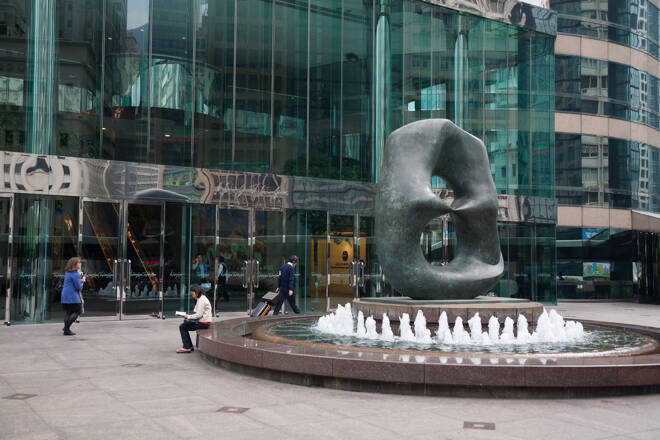Advertisement
Advertisement
Hang Seng Index, Nikkei 225, ASX 200: Forecasting Responses to US and China Indicators
By:
Key Points:
- The ASX 200 and Hang Seng Index can respond to recent economic indicators from China and the US amid ongoing concerns about the Chinese real estate market.
- Japanese government intervention threats may leave the Nikkei at risk of another loss.
- The ASX 200 faces a testy start to the second quarter as iron ore prices stumble on overnight.
US Equity Markets React to Inflation and Manufacturing PMIs
On Monday, the US markets had an opportunity to react to the US Personal Income and Outlays Report and Fed Chair Powell commentary. The Core PCE Price Index increased by 2.8% year-on-year in March after rising by 2.9% year-on-year in February. Personal income increased by 0.3% month-on-month, with personal spending rising by 0.8% month-on-month.
Fed Chair Powell spoke after the report, warning the Fed was in no hurry to cut interest rates.
US Manufacturing PMI numbers from Monday also needed consideration. The ISM Manufacturing PMI increased from 47.8 to 50.3 in March, impacting the Dow and the S&P 500.
On Monday, the Dow and the S&P 500 declined by 0.60% and 0.20%, respectively. The Nasdaq Composite Index ended the session up 0.11%.
China Economic Outlook Improves on Rising Domestic and Overseas Demand
Private sector PMI numbers from China will set the tone for the Tuesday session. NBS Manufacturing and Non-Manufacturing PMI numbers beat forecasts.
The all-important Caixin Manufacturing PMI also signaled an improving demand environment. In March, the Caixin Manufacturing PMI increased from 50.9 to 51.1. The figures will likely influence buyer appetite for ASX 200 and Hang Seng Index-listed stocks.
Asian Economic Calendar: Aussie Manufacturing and the RBA in Focus
On Tuesday, the Asian economic calendar will put the ASX 200 in focus. Finalized Australian manufacturing PMI numbers for March, Aussie labor market data, and the RBA Meeting Minutes warrant investor attention.
A more dovish outlook on the RBA rate path could influence interest rate-sensitive ASX 200-listed stocks.
However, commodity price trends may also influence buyer demand for riskier assets. Crude oil and gold prices were higher on Monday. Iron ore prices ended the Monday session with heavy losses that could impact Aussie mining stocks. Concerns about the Chinese real estate market impacted iron ore prices.
Yen and Yuan Trends Remain in Focus
The Nikkei found no support from a stronger USD/JPY on Monday, with the Yen hovering in the intervention zone. The USD/JPY pair was up 0.04% to 151.375 at the close of the Japanese market session. A break above the 152 barrier could force the Japanese government to intervene. Nikkei-listed export stocks would bear the brunt of an intervention.
The USD/CNY remains another focal point, with more sizeable swings likely to test market confidence after Monday’s Mainland Chinese equity market gains. On Monday, the CSI 300 rallied 1.31%.
The Futures Markets
On Tuesday, the ASX 200 looks set for a negative start to the second quarter. According to the SPI futures, the ASX 200 is set to open the session down 34 points, while the Nikkei eyes an 80-point gain.
ASX 200
The ASX 200 rallied 0.99% on Thursday. (The ASX 200 was closed for trading on Friday). Gold (XAU/USD), mining, oil, and tech stocks had positive ends to the quarter. The S&P ASX All Technology Index (XTX) advanced by 0.51%. Retail sales and consumer expectations fell short of expectations, raising bets on an RBA rate cut, contributing to the gains.
Gold (XAU/USD) stock Northern Star Resources Ltd. (NST) and Evolution Mining Ltd (EVN) saw gains of 1.69% and 1.70%, respectively.
Woodside Energy Group Ltd (WDS) and Santos Ltd (STO) advanced by 0.63% and 0.65%, respectively.
BHP Group Ltd (BHP) and Fortescue Metals Group Ltd. (FMG) rallied 1.35% and 2.02%, respectively. Rio Tinto Ltd. (RIO) gained 0.69%. Iron ore price gains contributed to the positive session.
However, bank stocks had a mixed end to the quarter. ANZ Group Holdings Ltd. (ANZ) and Westpac Banking Corp. (WBC) advanced by 0.48% and 0.38%, respectively. Commonwealth Bank of Australia (CBA) gained 0.28%. National Australia Bank Ltd. (NAB) bucked the trend, falling by 0.14%.
Hang Seng Index
On Thursday, the Hang Seng Index advanced by 0.91%. (The Hong Kong markets were closed on Friday). Tech stocks recovered losses from Wednesday. The Hang Seng Tech Index (HSTECH) rallied 2.48%. Property stocks also ended the quarter on a positive footing. The Hang Seng Mainland Properties Index (HSMPI) gained 0.70%.
Tencent (0700) rose by 0.60%, with Alibaba (9988) rallying 2.11%.
Bank stocks had a mixed end to the quarter. HSBC (0005) advanced by 0.08%. China Construction Bank (0939) and Industrial Commercial Bank (1398) ended the day with losses of 1.67% and 0.76%, respectively.
The Nikkei 225
(Graph for reference purposes only)
The Nikkei slid by 1.40% on Monday, with intervention threats impacting export-linked stocks.
Bank stocks resumed their downward trends. Sumitomo Mitsui Financial Group Inc. (8316) and Mitsubishi UFJ Financial Group Inc. (8306) tumbled 3.48% and 3.98%, respectively.
Nonetheless, it was a mixed session for the main components of the Nikkei.
Tokyo Electron Ltd. (8035) slid by 3.21%, with Softbank Group Corp. (9948) declining by 1.47%. Fast Retailing Co. Ltd. (9983) and KDDI Corp. (9433) ended with losses of 0.47% and 0.65%, respectively. Sony Group Corporation (6758) bucked the trend, gaining 0.62%.
For upcoming economic events, refer to our economic calendar.
About the Author
Bob Masonauthor
With over 28 years of experience in the financial industry, Bob has worked with various global rating agencies and multinational banks. Currently he is covering currencies, commodities, alternative asset classes and global equities, focusing mostly on European and Asian markets.
Advertisement
